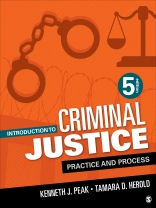A practical and applied introduction to Criminal Justice
Introduction to Criminal Justice: Practice and Process shows students how to think practically about the criminal justice system by offering them a proven, problem-based approach to learning. Bestselling authors Kenneth J. Peak and Tamara D. Herold draw on their many years of combined practitioner and academic experience to explain the importance of criminal justice and show how key trends, emerging issues, historical background, and practical lessons can be applied in the field. The new
Fifth Edition includes learn-by-doing activities at the end of each chapter, review questions, case studies, and a list of key terms, allowing students to enhance their critical analysis and problem-solving skills.
Daftar Isi
Part I: Criminal Justice as a System: The Basics
Chapter 1: Fundamentals of Criminal Justice: Essential Themes and Practices
Chapter 2: Foundations of Law and Crime: Nature, Elements, and Measurement
Chapter 3: Theories of Criminality and Crime
Chapter 4: Ethical Essentials: Doing Right When No One Is Watching
Part II: The Police
Chapter 5: Police Organization: Structure and Functions
Chapter 6: Police at Work: Patrolling and Investigating
Chapter 7: Policing Methods and Challenges: Issues of Force, Reform, and Liability
Chapter 8: Expounding the Constitution: Laws of Arrest, Search, and Seizure
Part III: The Courts
Chapter 9: Court Organization: Structure, Functions, and the Trial Process
Chapter 10: The Bench and the Bar: Those Who Judge, Prosecute, and Defend
Chapter 11: Court Methods and Challenges: Sentencing and Punishment
Part IV: Corrections
Chapter 12: Prisons and Jails: Structure and Function
Chapter 13: The World Behind Bars: The “Keepers” and the “Kept”
Chapter 14: Corrections in the Community: Probation, Parole, and Other Alternatives to Incarceration
Part V: Spanning the System: Methods and Issues
Chapter 15: Juvenile Justice: Philosophy, Law, and Practices
Chapter 16: On the Crime Policy and Prevention Agenda: Immigration, Mass Murder, the Cyber Threat
Tentang Penulis
Tamara D. Herold is an associate professor of criminal justice and graduate director at the University of Nevada, Las Vegas (UNLV). She holds a doctorate from the University of Cincinnati. Her research interests include crime opportunity structures, place management, and crowd violence. She is the recipient of UNLV’s Spanos Distinguished Teaching Award, Faculty Excellence Award, and Greenspun College of Urban Affairs Teaching Award. Her publications propose, extend, or test crime science theoretical models. They also help to translate research findings into practice and policy. Her work has appeared in various outlets, including Criminology and Justice Quarterly. She has published numerous practitioner-focused research papers, including two Problem-Oriented Policing Guides funded by the COPS Office and research monographs selected as Herman Goldstein Excellence in Problem-Oriented Policing Award finalists. Her book Preventing Crowd Violence (co-edited with Johannes Knutsson), has been translated into two foreign languages. Dr. Herold serves as director of UNLV’s Crowd Management Research Council, and conducts research and training for police agencies, major sports leagues, and private industries.












